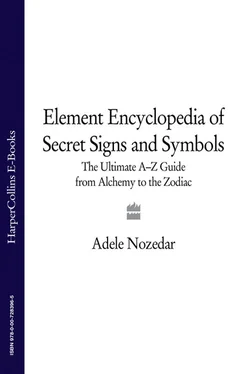There are several people without whom this book would never have been written. I’d like to thank Katy Carrington, Terence Caven, Jeannine Dillon, Chris Wold, Simon Gerratt, Graham Holmes, Kate Latham, Faith Booker, and Laura Summers at HarperCollins. Charlotte Ridings, Martin Noble, and Mark Bolland were the editors. I’d also like to thank Wanda Whiteley.
Any book about symbols would be nothing without the illustrations. Paul Khera has done the bulk of these, with additional thanks to Anat Cederbaum, Myong Hwi Kim, Kruti Sanaija, and Yuki Nakamura for advice and help with some aspects of these pictures. I am also lucky enough to have Finlay Cowan contribute images to this book.
Other illustrators include David Little, Lyndall Fernie, and Kalavathi Devi. I would also like to thank Willa and Milo Seary for their drawings. Thanks are also due to Gavin and Davina Hogg, Sigorour Atlason, Caroline Danby, Tania Ahsan, Hamraz Ahsan, Carla Edgley, Judy Roland, Theo Chalmers, the Order of Bards, Ovates and Druids, Stuart Mitchell, and the good people of Raquetty Lodge, Hay on Wye. Most of all I have to thank starship commander Adam Fuest for putting up with my obsession about this book and my possible bouts of absent mindedness about anything else during the writing of it.
FIRST SIGNS: THE BASIC SHAPES OF SYMBOLS
There are certain elemental structures that occur repeatedly, not only as component parts of more elaborate symbols, but also with rich meanings of their own. In fact, it’s probably true to say that the simpler the symbol, the more scope there is for interpretation; ergo, the more meaningful it is and, paradoxically, the more complex it becomes. These primary shapes transcend barriers of time, geography, and cultural context, part of a universal language that goes before, and beyond, words. Don’t be fooled into thinking that these basic shapes are as self-explanatory as to need no analysis. A true understanding of what they represent can only add to the comprehension of the more elaborate shapes and symbols that follow in this section.
The elements of a symbol are defined only by the space that is a part of its construction. Like the wind, the effect of space is gauged by its effect on the things within it or surrounding it. The concept of space, the void, is a profound part of our experience. To reach a state of “emptiness” is, for many, the ultimate spiritual experience and a way of connecting to the Absolute. When John Lennon wrote “Imagine,” whose lyrics gradually strip away the trappings of the material world, it was this idea that inspired him.
To be aware of the possibility of space within a flat, two-dimensional representation is to give that shape substance and a new kind of reality that lifts it off the page and makes it real. Space is not flat and cannot be confined by lines on a piece of paper. The page and the shape on it do not exist in isolation, but are a part of a greater cosmos. This book and you, the reader, are a part of this equation.
The concept of zero is a space. Indeed, the realization that “nothing” can be “something” marked a profound leap forward in man’s development. All creation myths begin with a Void, symbolic of potential.
Although attempts to explain the concept of space are inevitably faulty, it might help to think of a blank page. Before a mark is made upon the paper, the potential for what might appear there is so vast as to be unimaginable, a consideration which causes consternation for some artists and writers. Without this space, there is no arena for anything else to exist. This absence of any thing means that no thing is the most important symbol in the World.
A dot might seem to be an unassuming little thing, the first mark on the pristine sheet of paper. In this case, the dot is a beginning. But see what just happened there? The dot, an essential component in the structure of the sentence, closed it, making it a symbol of ending. Therefore, the dot is both an origination and a conclusion, encompassing all the possibilities of the Universe within it, a seed full of potential and a symbol of the Supreme Being. The dot is the point of creation, for example the place where the arms of the cross intersect.
The dot is also called the bindhu, which means “drop.” The bindhu is a symbol of the Absolute, marked on the forehead at the position of the third eye in the place believed to be the seat of the soul.
The presence of dots within a symbol can signify the presence of something else. A dot in the center of the Star of David marks the quintessence, or Fifth Element. It also acts as reminder of the concept of space. The decorated dots that surround the doorways of Eastern temples are not merely ornamental devices but have significance relevant to the worshippers. Dots frequently appear in this way, acting as a sort of shorthand for the tenets of a faith. In the Jain symbol, for example, the dots stand for the Three Jewels of Jainism. The dots in each half of the yin-yang symbol unify the two halves: one dot is “yin,” the other “yang.” Together they demonstrate the interdependence of opposing forces.
The next logical magical symbol is the circle. Effectively an expansion of the dot, the circle represents the spirit and the cosmos. Further, the circle itself is constructed from “some thing” (the unbroken line) and “no thing” (the space inside and outside this line). Therefore, the circle unifies spirit and matter. The structure itself has great strength—think of the cylindrical shape of a lighthouse, built that way in order to withstand the fiercest attack by a stormy sea.
The physical and spiritual strength of this symbol are there because the perfect circle has no beginning and no end; it is unassailable. This power is the reason why the circle is used in magical practices such as spell-casting. The magic circle creates a fortress of psychic protection, a physical and spiritual safe haven where unwanted or uninvited entities cannot enter.
Hermes Trismegistus said of the circle:
God is a circle whose center is everywhere and circumference is nowhere.
Where would ancient man have seen the most important circles? Obviously, in the Sun and the Moon. As the Sun, the circle is masculine, but when it is the Moon, it is feminine. Because the passage of time is marked by the journey of the Sun, Moon and stars in orbit around our Earth, the circle is a symbol of the passage of time. In this form, it commonly appears as the wheel.
Because the circle has no divisions and no sides, it is also a symbol of equality. King Arthur’s Round Table was the perfect piece of furniture for the fellowship of Knights who were each as important as each other. Similarly, the Dalai Lama has a “circular” Council.
Perhaps the most prominent arc of the natural world appears in the elusive form of the rainbow, which primitive man saw as a bridge between the Heavens and the Earth.
As a part of a circle, the arc symbolizes potential spirit. The position of the arc is important. Upright, shaped like a cup or chalice, it implies the feminine principle, something that can contain the spirit. If the arc is inverted, then the opposite is true and it becomes a triumphal, victorious, masculine symbol. As such, the arc can take the form of an archway. The vaulted or arched shape of many holy buildings, from a great variety of different faiths, represents the vault of the Heavens. The arc shape often appears in planetary symbols.
Man, alone in the animal kingdom, stands upright, so the vertical line represents the physical symbol of the number One, man striving toward spirit. This simple line is the basic shape of the World Tree or Axis Mundi that connects the Heavens, the Earth and the lower regions. It is not only a basic phallic symbol but also signifies the soul that strives for union with the Divine.
Читать дальше












